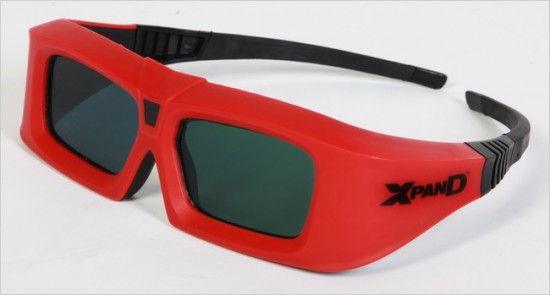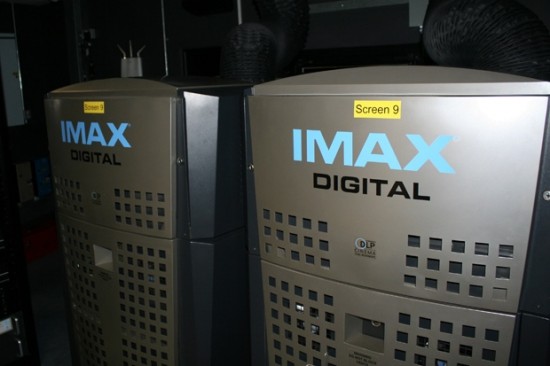Q&A: Which Is The Best 3D Format?
Lets face it, 3D movies are not going away any time soon. Every year we're seeing more and more films being released and re-released in 3D. So why not experience the 3D in the best way possible?
There are several 3D formats. RealD? Dolby 3D? IMAX 3D? XpanD 3D? Which is the best 3D format? I attempt to answer that question in this weeks edition of Q&A. We'll take a look at the technical differences, and the advantages and disadvantages between the four big choices. We'll show you why your local multiplex picked one format over another, and we even got some of the top 3D filmmakers and 3d experts to comment.
The two basic 3D techniques used in theaters right now are Active and Passive.
In the US, there are four big choices in theatrical 3D projection — IMAX, RealD, Dolby 3D and Xpand.
I'm lucky enough to live in a city (Los Angeles) that has a bunch of theaters which offer a variety of different 3D format options. I'm sure many /Film readers live in small towns which offer only one of the formats. Before we look at which of the formats are better or worse, we should first take a look at why a movie theater owner (exhibitor) might choose one of these formats over the others.
US readers may not have heard of XpanD, as the company has a small marketshare in the states but is a huge player internationally. The technology has been adopted by more than 3,500 cinemas worldwide, and is sold as a "cost-effective solution and doesn't require silver screen." Their active shutter glasses are reminiscent of the glasses that are used for home 3D televisions. In fact, XpandD produces a set of universal 3D glasses that work both in theaters using the XpanD 3D technology and select 3D televisions. (See a list here.) XPand even produced a 4-minute cheesy informercial about this, which you can watch below:
While the format isn't as popular in the US as it is internationally, its worth talking about for a variety of reasons:
Xpand's X101 3D glasses use battery-powered LCD active shutters that open and shut. They are costly, around $35-$50 a piece, but are said to have a lifetime of up to 5000 shows. At five showings a day, the glasses are rated to last nearly three years. At that rate, the glasses have an end life cost of about a penny per screening — but that doesn't include the costs associated with charging and cleaning the glasses in-between each showtime. (Which is a lot more work than it sounds.)
The technology also does not require a theater to buy and install a new silver screen. So while XpanD has some big upfront costs for glasses, charging and cleaning equipment, it might be the most affordable in the long term for an exhibitor. On the other hand, the charging and cleaning come at the cost of man hours from theater staff throughout the day.
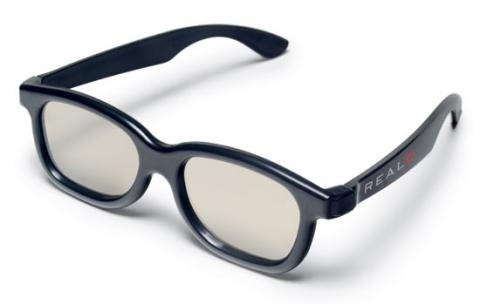 RealD works on 5,000 screens worldwide, and is endorsed by master 3D filmmaker James Cameron. The technology uses circular polarization which requires a silver screen that reflects the polarized light to be installed in the theater. The glasses are cheap and cost only 50 cents each. They are essentially disposable, requiring no cleaning, which also means that new glasses are purchased for each and every screening. RealD can deliver quality 3D on a screen up to over 80 feet wide with a single digital cinema projector (Other 3D technologies would need multiple projectors to project quality 3D on a screen of this size).
RealD works on 5,000 screens worldwide, and is endorsed by master 3D filmmaker James Cameron. The technology uses circular polarization which requires a silver screen that reflects the polarized light to be installed in the theater. The glasses are cheap and cost only 50 cents each. They are essentially disposable, requiring no cleaning, which also means that new glasses are purchased for each and every screening. RealD can deliver quality 3D on a screen up to over 80 feet wide with a single digital cinema projector (Other 3D technologies would need multiple projectors to project quality 3D on a screen of this size).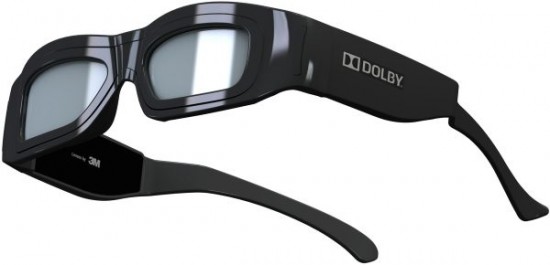 Dolby's 3D technology is being used on 2,200 screens worldwide. Dolby glasses are reusable and cost exhibitors around $12 per pair. Unlike RealD, Dolby 3D can be projected onto a normal white screen, requiring no equipment change for the exhibitor in that respect. While the eyewear doesn't require charging, it does require cleaning after every screening.
Dolby's 3D technology is being used on 2,200 screens worldwide. Dolby glasses are reusable and cost exhibitors around $12 per pair. Unlike RealD, Dolby 3D can be projected onto a normal white screen, requiring no equipment change for the exhibitor in that respect. While the eyewear doesn't require charging, it does require cleaning after every screening.
Now lets take a look at the 3D formats themselves from the perspective of the moviegoer:
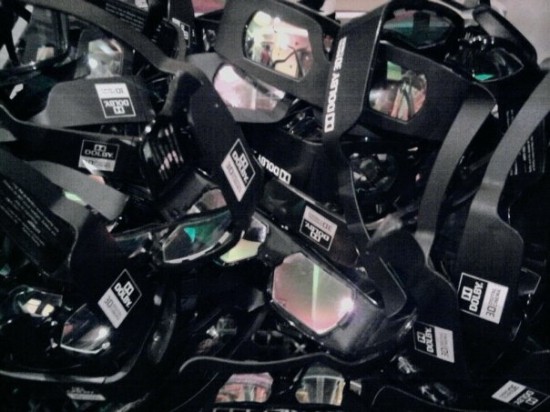 Dolby 3D is the newest of the 3D technologies currently on the market, using specific wavelengths of red, green, and blue for the right eye, and different wavelengths of red, green, and blue for the left eye. 3D professionals we've talked with consider this format because it provides more vivid and accurate colors while keeping a sharper image with no ghosting (the phenomenon of seeing a distracting shadow image behind or next to the 3D image).
Dolby 3D is the newest of the 3D technologies currently on the market, using specific wavelengths of red, green, and blue for the right eye, and different wavelengths of red, green, and blue for the left eye. 3D professionals we've talked with consider this format because it provides more vivid and accurate colors while keeping a sharper image with no ghosting (the phenomenon of seeing a distracting shadow image behind or next to the 3D image).
Dolby 3D is typically much darker than RealD due to the Color Wheel in the projector and the glasses. If the movie theatre has a higher wattage lamp in the projector than normally used for 2D (which is recommended, but often not followed as it is more costly), the brightness can be even better than that produced by RealD's technology and a silver screen. Dolby presents actual depth, acting more as a window to a 3D world than in-your-face spectacle. I have found the lenses are more reflective, which can cause trouble if there is any light behind you (I sometimes see movies in small screening rooms where the projector is very visible not far behind your head). Also, I've been to theaters in the past that have the subtitles for the deaf being projected from the back, which could be reflected inside the glasses. The glasses are washed in between screenings — often resulting in distracting splotches and water marks on the lens.
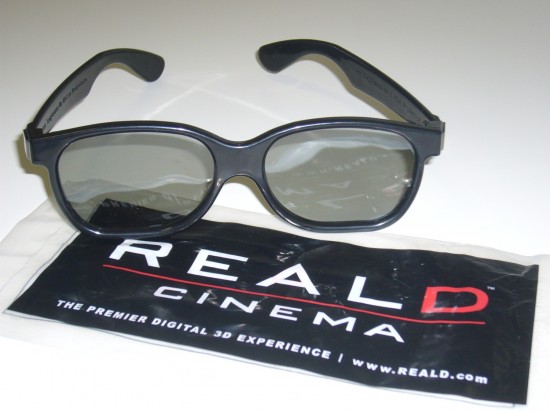 RealD uses circular polarized glasses instead of linear polarization, which is considered to be better because viewers are able to tilt their head without any loss of 3D. The RealD 3D technology delivers twice the light of other 3D technologies, and with 3D projection, the more light the better.
RealD uses circular polarized glasses instead of linear polarization, which is considered to be better because viewers are able to tilt their head without any loss of 3D. The RealD 3D technology delivers twice the light of other 3D technologies, and with 3D projection, the more light the better.
The technology specializes in perception of actual depth, acting more as a window to a 3D world. (In comparison, IMAX provides more immersive pop-out experience, which packs a WOW-factor but can be tiring on the eyes.) The format has less ghosting than others, and audiences consider it easier to keep track of quick action sequences. RealD is said to suffer from uneven illumination issues as the silver screen reflects the light stronger in the middle than it does at the sides of the silver screen. The issue is less evident when you sit in the middle of the theater, but is said to be more noticeable when sitting on the sides of a cinema. The glasses are considered the most comfortable of the bunch, and also the most reliable in terms of lens cleanliness as each pair is new and disposable.
Photo via WiredIMAX 3D is the oldest of the current 3D technologies found in movie theaters. The technology uses linear polarized glasses, which means that if viewers tilt their head off off the normal 90 degree axis, the 3D effect will be lost. Moviegoers who are unable to keep still or stay straight during a film could experience headaches or eyestrain. The technology results in a lower contrast in dark scenes, some ghosting artifacts and audiences sometimes experience problems refocusing their eyes quickly enough in fast-moving action sequences. The large screen is seen to be more immersive, giving audiences more pop-out foreground 3D than the other formats.
But this intense 3D experience can be tiring on your eyes, especially in longer films. Remember, The original IMAX 70mm huge screen theaters were created for 60-80 minute 1.44:1 aspect ratio nature documentaries, not 3-hour Hollywood sci-fi tentpole movies. In fact, James Cameron requested that 1.87:1 aspect ratio version of Avatar be projected smaller, in the middle of the IMAX screen, to allow for optimal presentation. I have also found that you must be near the center in the last five rows of a traditional IMAX theatre for an optimum experience with a widescreen movie.
The glasses are cleaned between screenings, but many of the reusable glasses often feature visual faults, like scratches or visible marks. The Digital IMAX theatres uses two 2K-resolution Christie projectors (pictured above) to project two 2K images over each other, producing an image that is potentially twice as bright as a normal movie theater. Most of the IMAX screens curve inward at the edges which helps retain light, resulting in a brighter presentation.
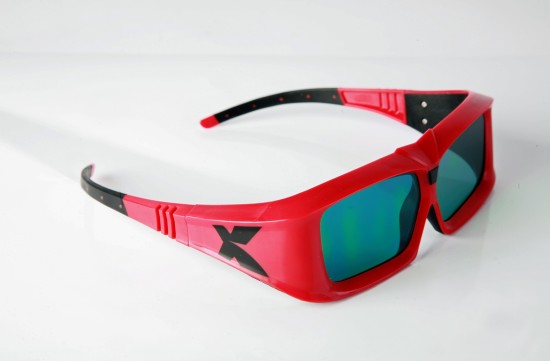 Xpand doesn't suffer from uneven illumination issues due to not having a silver screen. The glasses are bulky and considered the least comfortable of the bunch. I once attended a screening at the Arclight in Hollywood where the glasses ran out of batteries, forcing me to exchange my glasses with the attendant outside the theater. Luckily it wasn't during the actual movie. But this issue is slight as the issue should not occur if the movie theater is conducting proper handling of the glasses and recharging when required.
Xpand doesn't suffer from uneven illumination issues due to not having a silver screen. The glasses are bulky and considered the least comfortable of the bunch. I once attended a screening at the Arclight in Hollywood where the glasses ran out of batteries, forcing me to exchange my glasses with the attendant outside the theater. Luckily it wasn't during the actual movie. But this issue is slight as the issue should not occur if the movie theater is conducting proper handling of the glasses and recharging when required.
So which 3D format is the brightest or the best? I decided to ask a couple 3D experts and 3D filmmakers:
 Jon M. Chu, director of Step Up 3D, Justin Bieber: Never Say Never and the upcoming G.I. Joe 2: Retaliation:
Jon M. Chu, director of Step Up 3D, Justin Bieber: Never Say Never and the upcoming G.I. Joe 2: Retaliation:
Real D was always my preferred projection system. I think the glasses are low profile so it doesn't feel like you're wearing a robot on your face and because we shot with passive glasses it felt more like the movie we intended to make. There was something about not having a flashing, stuttering presence in your line of vision that helped relax my eyes and my brain a lot more than the active systems. I also liked having a SILVER SCREEN because it helped retain the brightness that we set in the DI. We even did one of the BIGGEST 3D Real D projections at our premiere for Never Say Never at the Nokia Live theater where we had a huge screen (70 feet diagonal silver screen I think?) and over 4,300 people watching in 3D!!! Pretty awesome and every seat looked great. Trust me, I sat in every seat to make sure and we blocked off the ones that were too much at an angle.
 Todd Strauss-Schulson, director of A Very Harold & Kumar 3D Christmas:
Todd Strauss-Schulson, director of A Very Harold & Kumar 3D Christmas:
Here are my thoughts, from my limited knowledge. The real deciding factors are glasses vs ghosting. you gotta pick the lesser of two evils. Dolby has very little ghosting, however uses reuseable glasses which means they are collected after the screening and then steamed to disinfect. Every once in a while you'll go to a theater and get soggy wet glasses... pretty gross, and if you're like me and only think about catching PINK EYE whenever you put on a pair of 3d glasses the dampness is unsettling... infection LOVES DAMPNESS! Real D is more wide spread which is why we mastered to that on HK3D. With Real D the glasses feel less cumbersome but do have more ghosting then Dolby. As far as the neurotic pink eye quotient goes, Real D glasses are collected then melted down to make new glasses at the factory, so breath a sigh of sweet germless relief! XpanD has great cancellation (low ghosting) but the glasses are active. Active glasses have batteries in them which can tend to make them heavy and uncomfortable. All I know is XpanD is big in the Euro market, and Europeans appear to have less cases of conjunctivitis than Americans... so... there that is.
 Todd Farmer, writer of My Bloody Valentine 3D and Drive Angry:
Todd Farmer, writer of My Bloody Valentine 3D and Drive Angry:
RealD seems to give a broader 3D experience with a wider visual dynamic range, while the colors of Dolby feel truer and generally more lush but the 3D isn't as extreme. XpanD often feels like the worst of RealD and Dolby.
 Jason Fairley, the Stereoscopic Supervisor on Happy Feet Two:
Jason Fairley, the Stereoscopic Supervisor on Happy Feet Two:
Anything with two projectors is likely to be brighter than one. I would guess that digital IMAX is generally the brightest, but results can vary from cinema to cinema so that's a gross simplification. A really powerful single projector and high gain screen can look great. Because of this it's hard to claim any one system is the 'best', they all have their pros and cons. I've found traditional IMAX is more prone to ghosting (aka cross talk) than RealD, while Dolby 3D has a different kind of ghosting which is less noticeable but there's a chance the colours are minutely shifted. XPAND has heavier glasses which can be uncomfortable... it gets a bit arbitrary and personal quite fast. Most post-production studios will have more than one system in-house depending on whether they've installed a silver screen or not.
Conclusion
So which 3D format is the best? There isn't a clear cut answer, and like most choices in life — it's mostly subjective.
I personally don't like the bulkiness of the XpanD glasses, as they don't fit well over my own glasses. And as I mentioned earlier, I once had the batteries in the XpanD glasses run out while in a movie theater. In a perfect world, the batteries should be fully charged and the glasses should be perfectly cleaned/sanitized in between screenings — but we don't live in a perfect world. My battery incident happened at the Hollywood Arclight, which is considered the pinnacle of movie theaters in the United States. If it can happen there, it can happen anywhere.
I tend to prefer the 3D I've seen with RealD. I also appreciate the fact that theaters offer new RealD 3D glasses for each screening. This means that the glasses don't feature scratches, blotches or imperfections that I've experienced with the competition. The slightest scratch or imperfection can ruin my experience.
Even with that said, the huge IMAX screen have made the 3D experiences for films like Avatar and Tron: Legacy unmatched and completely immersive. I just don't think the 3D wow factor that the huge screen provides is right for all 3D movies.

